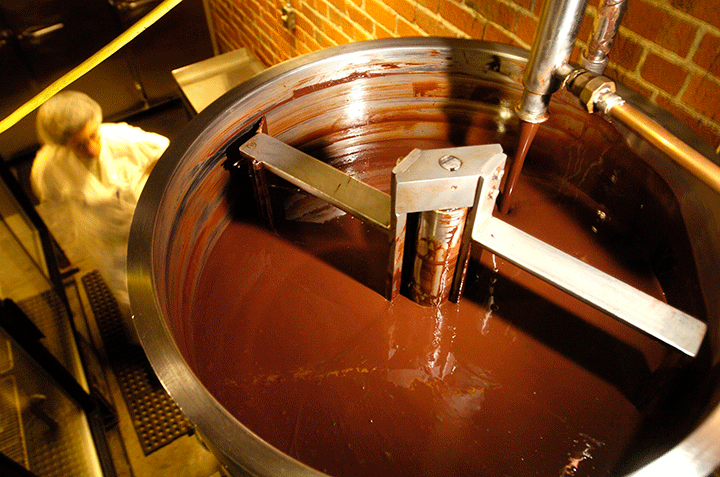We all know that chocolate isn’t good for us, but new research claims to have found a manufacturing method that could change that.

READ MORE: Mars banned from selling M&Ms in Sweden after chocolate trademark dispute
Though we eat chocolate in solid form for the most part, to manufacturers, chocolate is a liquid. And going from a liquid to a solid state is a manufacturing process that requires it to go through production pipelines. However, reducing the fat content in chocolate ends up clogging up these pipelines. That’s because there is a minimum percentage of fat needed to allow the proper flow of liquid chocolate.
But a new process proposed by researchers in the department of physics at Temple University in Philadelphia has found a way to produce low-fat chocolate without clogging up the pipelines.
The study, partially funded by Mars Chocolate Inc., was published in the Proceedings of the National Academy of Sciences.
The science behind producing low-fat chocolate lies in producing lower viscosity, or the semi-fluid consistency, of the liquid chocolate.
Rongja Tao, lead author of the paper, had studied crude oil viscosity. He was approached two years ago by a company (on behalf of Mars) asking if he was interested in creating lower viscosity in the chocolate manufacturing process. At the time, no one had really thought of making chocolate low-fat.
The research shows that applying an electric field charge in the direction of the flow of liquid chocolate might reduce viscosity, thereby allowing manufacturers to reduce the minimum amount of melted fat needed to maintain proper flow within the pipeline.
The average chocolate bar contains about 40 per cent fat, comprised of cocoa, sugar, milk solids and other particles that are suspended in liquid fat, such as cocoa butter. That fat increases calories, which contributes to obesity.
Over the years, there has been much research into reducing fat in chocolate. Though Proctor & Gamble and Nabisco have both attempted the process, it wasn’t accepted by many countries, including Canada, which stipulates that cocoa butter must be the sole fat source in chocolate. Another challenge has been producing chocolate that appealed to the public: sometimes the process would make the chocolate feel and look different.
READ MORE: 5 ‘healthy’ foods that aren’t as healthy as you thought
Using the process of electrorheology, the research team was able to reduce the viscosity in a sample of Mars chocolate by 43.5 per cent, which resulted in a fat reduction of 10 per cent. And, Tao said, the chocolate remained solid and felt the same as currently produced chocolate.
But is low-fat chocolate actually healthier?
“When you look at calories, fat is very high-calorie density,” said Robert Lencki, an associated professor at the University of Guelph’s Department of Food Science. He has also studied and produced a method of reducing fat in chocolate.
“And depending on what kind of chocolate you eat, almost 50 per cent of it is fat, so if you take the calories out, then it’s obviously going to have lower calories.” This does, in fact, make the chocolate healthier.
Lencki and Tao both said that there has been research that shows that some properties of chocolate have been proven to be good for you. But chocolate as a whole just isn’t.
“Healthy has two different meanings,” Tao said. “Even cocoa butter has been proven to have positive effects on the heart. But too much fat leads to obesity, too many calories. That’s the issue … That’s why we want to try to reduce the fat, to make it healthy.”
But, there are repercussions. Fat tends to make you feel full. But if you reduce that fat, it reduces that satiety. So instead of grabbing one chocolate bar, you might find yourself eating more.
“Everything is a trade off,” said Lencki.
While the research is still new, the research team hopes to refine the process and lead to the production of low-fat chocolate. Tao said that it could even happen within a year or two.
“I think most people like chocolate,” Tao said. “I hope this makes it more popular.”




Comments